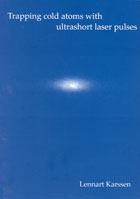
On October 8th 2008 I defended my PhD thesis titled ‘Trapping cold atoms with ultrashort laser pulses’ in the field of experimental physics at the University of Utrecht in the Netherlands. In short, the research I did was in the field of atom optics and ultrafast dynamics. I built a setup with which atoms could be trapped and cooled with laser light. Subsequently we investigated what happens if the lasers are switched from a continuous beam to ultrashort pulses. It proved to be possible to trap atoms in a trap made by these short laser pulses. Subsequently several characteristics of the atoms in both types of traps were investigated.
The official abstract follows below. My thesis can be downloaded from this site or from the official archive of the UU.
The official abstract:
The aim of this research is to pave the way for making a trap for cold neutral atoms based on the force generated by pulses of a mode-locked laser. As an onset towards such a trap we decided to use a far-off-resonance trap (FORT) loaded with cold rubidium atoms from a magneto-optical trap (MOT). Our FORT setup consists of a titanium-sapphire laser that can operate both in continuous wave mode and in mode-locked mode. Our MOT setup uses a magnetic field gradient, and two diode lasers whose frequency is locked very accurately to the atomic transition using polarisation spectroscopy. Since the measurements we do require very precise timing of the order of less than one millisecond between the various phases of the experiment, a time-sequencing program was developed. Using this sophisticated setup, several characteristics of FORTs made with continuous and pulsed lasers were analysed. For example, we have investigated the loading behaviour of the traps and found that under general circumstances there is no significant difference. However, under special conditions it is possible to load more atoms into a pulsed trap. The lifetime of the number of atoms in the trap shows no dependence on the power of the trap laser in the continuous case. For the pulsed trap, however, the increased scattering due to the high peak intensities of the pulses does limit the achievable lifetimes. Moreover, due to the presence of a large number of photoassociation lines, i.e. lines were loosely bound molecules are formed by the interaction of two atoms an a photon, the two-particle losses depend heavily on the wavelength of the trap laser. Furthermore we have done measurements of the temperature of the trapped atoms, which revealed that the temperature is a constant fraction of the trap depth. We also looked at the effects of parametric excitation of the atoms in the FORT. The anharmonicity of the trap formed by the titanium-sapphire laser results in interesting physics, including a change in the average temperature of the atoms, depending on the modulation frequency. We also investigated the trapping behaviour of the FORT at low pulse repetition rates by switching the laser intensity on and off on a kHz scale. We investigated the dependence of the number of atoms on the polarisation of the FORT laser light, both for continuous and pulsed traps. Atoms can be trapped at elliptical polarisations as well, although the number of trapped atoms is less. As the laser is detuned further to the red of the rubidium D line, this effect becomes less and less pronounced, as predicted by our model.
Leave a Reply